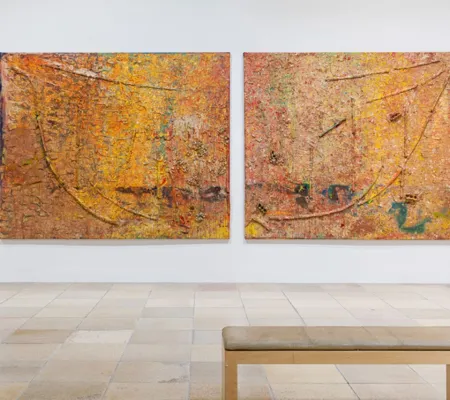“Frank Bowling: Mappa Mundi,” Haus der Kunst, Munich, 2017/18, installation view. Image courtesy of Texte Zur Kunst.
A review of Frank Bowling's 2016 Frank Bowling: Mappa Mundiexhibition at Haus der Kunst in Munich has been reviewed by UT Austin Art History graduate student Julia Elizabeth Neal in Texte Zur Kunst. Texte Zur Kunst is a German contemporary art magazine, featuring essays, interviews and reviews by international writers. In her analysis of Frank Bowling: Mappa Mundi, Neal chooses to examine the haptic experience of seeing the monumental size of Bowling's work as well as the relation between abstraction and its capacity for content.
Neal describes initial encounters in the gallery featuring “Australia to Africa” (1971), “Dog Daze” (1971), and “Penumbra” (1970).
"Above the differentiating hues of sandy-brown tiles modulating unevenly along the floor, the horizontal pull of the room nevertheless allows for the floor and matching benches to disappear from sight. From the center of the room, eyes respond to the entirety of contained yet vibrant canvases."
Frank Bowling: Mappa Mundi featured a large concentration of works by Bowling over his career, drawing particular attention to his celebrated "map paintings" (1967-1971). Neal analyzes the turn Bowling's work takes with the aforementioned map paintings.
"Marking an aesthetic and theoretical shift away from a purely formalist ideology of abstract painting, the 'Map Paintings' evince a growing interest in abstraction's seemingly expansive capacity for content. Thus, what is at stake in the exhibition is a meaningful entry into the artist's particular eloquence with paint and his patient yet terse unpacking of the politics of abstraction."
The final gallery in the exhibition was turned into an archival space of Bowling's critical writing with the intention by the curators, director Okwui Enwezor and assistant curator Anna Schneider. As Neal explains:
"The place of archival material in the show reveals how Enwezor and Schneider set out to structure a readerly experience alongside the visual. Rather than assign the investigation of Bowling's historical significance merely to the pages of the exhibition catalogue, the curators highlighted his integral role through the large reproductions of his writing. Readers of his essay, especially his 'Critique: A Discussion on Black Art,' encounter Bowling's provocative argument that definitions of Black Art as race-based are too simplistic. Discussing how critics disregarded the work of Black artists, he argued that deep engagement with their work entailed familiarizing oneself with a diversity of racialized experiences. As Bowling contends, 'What informs black artists' work is the black experience, which is global.'"


